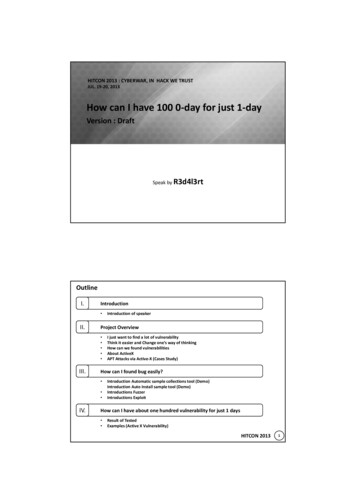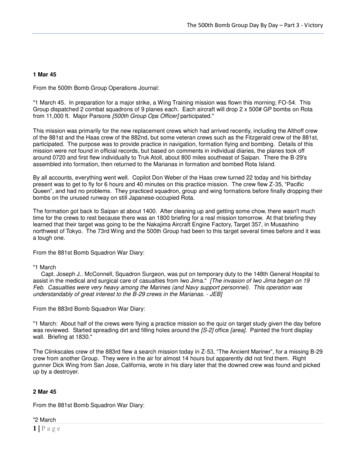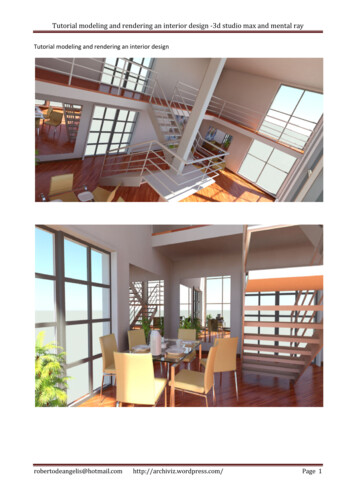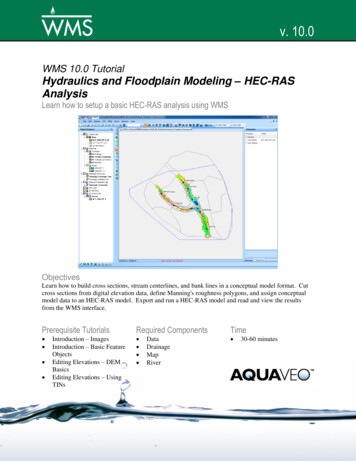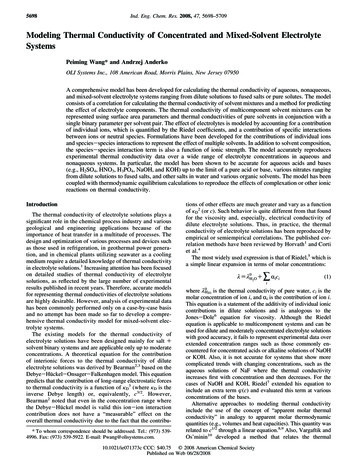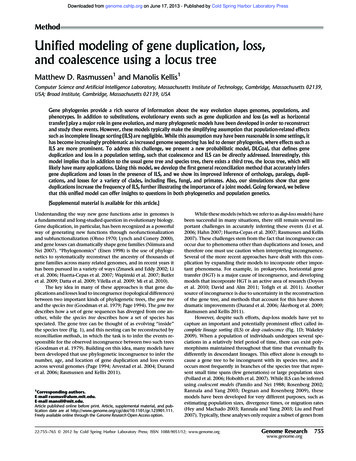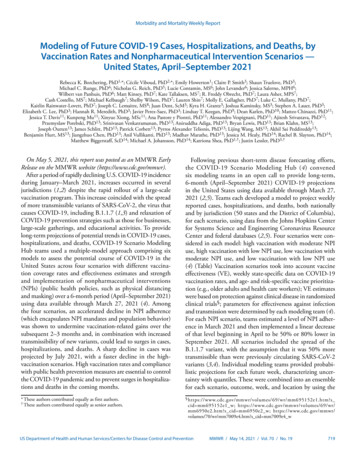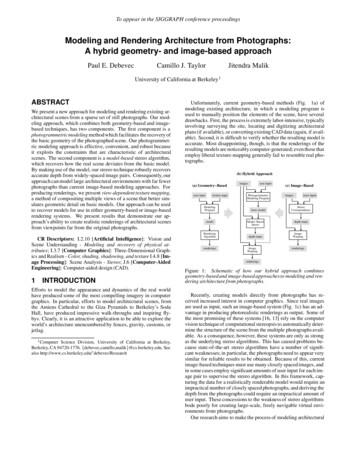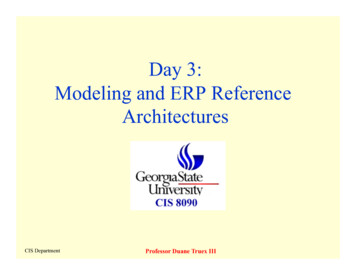
Transcription
Day 3:Modeling and ERP ReferenceArchitecturesCIS DepartmentProfessor Duane Truex III
Air Force Mentor-Protégé ProgramEnterprise Reference ArchitecturesRonald E. Giachetti, Ph.D.Associate ProfessorIndustrial and Systems EngineeringFlorida International UniversityDuane P. Truex, Ph.D.Associate ProfessorRobinson College of BusinessDepartment of Computer Information SystemsGeorgia State UniversityERP Methodology and Project Management
Air NATIONAL“Everything should bemade as simple aspossible, but not simpler”– Albert Einstein
Air NATIONALAgenda Modeling Theory Reference Architectures ARIS Reference Architecture as acommercial example utilized by SAP
Air NATIONALDefinitions Enterprise: a complex set of business processesthat can be designed to accomplish aspecific set of objectives. Architecture:" A description (often graphical) of thestructure of something." A structured plan, a framework on the basisof which a product or an organization of anenterprise can be constructed Reference model: a general model that can beused as a base to derive other models from. Reference Architecture: is a structured set ofmodels which represent the building blocks of thesystem.
Air NATIONALWhy we need ERP Reference Architectures ERP systems are complex and difficult to understand how theyoperate. A reference architecture is a model that describes ERP systems– helps people understand how they work. Use of reference architectures for:"""Business Process Reengineering (both ‘AS-IS’ and ‘TO-BE’modeling)TrainingConfiguration Reference architectures capture, standardize, and representthe commonalities found in business process reengineeringand enterprise integration projects (Vernadat 1996). Characterize the best-in-class management practices andsoftware solutions; i.e. knowledge management. Inclusion of all elements. Leverage the previous work done in enterprise engineering;i.e., learning.
Air NATIONALModels An abstract representation of reality thatexcludes much of the world’s infinitedetail. The purpose of a model is to reduce thecomplexity of understanding orinteracting with a phenomenon byeliminating the detail that does notinfluence its relevant behavior.
Air NATIONALAbstraction
Air NATIONALModeling Point #1 Modeling is the ‘art’ of abstraction,knowing what to include in model andwhat to leave out.
Air NATIONALA model reveals what its creator believes isimportant in understanding or predicting thephenomena modeled
Air NATIONALMecator’s ProjectionBut Africa ismore than 10times larger thanGreenland!
Air NATIONALPeterson’s Projection: Area Accurate
Air NATIONALModeling Point #2 All models are built with a purpose, thepurpose is determined by the modelcreator. Standard models have built inpurposes (for example, UML activitydiagrams or role activity diagrams).
Air NATIONALModel ViewsAFigure 1. Front view of physical object
Air NATIONALModel ViewsPossibility 1Possibility 2AAFigure 2. Two possible top views for the same front view
Air NATIONALEnterprise System zationCurtisFunctionBehaviorOrganizationor resourceinformation
Air NATIONALEnterprise Views A Reference Architecture for an ERP systemrequires the following views:""""Information or Data view – describes the datastructure of the entities or objects in the system.Function View – describes the functionssupported by the system (what the system does).Process View – describes how the systemcompletes the functions.Organization View – describes how the enterpriseis organized.
Air NATIONALModeling Point #3 Systems tend to be complex, ourmodels only abstract limited parts ofthe entire system (called a view). You need multiple views to understandthe entire system. We usedecomposition, but instead of ahierarchy into views. Views must be consistent!
Air NATIONALEnterprise Modeling Enterprise modeling has to fulfill several requirements toachieve efficient and effective enterprise integration:""provide a modeling language easily understood by non-ITprofessionals, but sufficient for modeling complex industrialenvironments.provide a modeling framework which: covers the life cycle of enterprise operation fromrequirements definition to end of life. enables focus on different aspects of enterprise operation byhiding those parts of the model not relevant for theparticular point of view. supports re-usability of models or model parts
Air NATIONALARIS The Architecture for InformationSystems (ARIS) developed in Germanyand adopted by SAP. Adheres to enterprise concepts foundin CIMOSA, GRAI, and other RA. Uses Event Process Chains to modelprocesses.
Air rocessedOfferprocessingData viewOrganizationalviewControl viewRequestOfferprocessing teFunctional view
Air NATIONALEvent Process Chains Event Driven Process Chains (EPC), which areone of the central components of theArchitecture for Integrated InformationSystems (ARIS) (Scheer 1995). Used by SAP in modeling business processessupported by their ERP package SAP R/3. EPC depict several important relationships ina business process."""Control Flow depicted as a sequence of eventfunction-event linkages.Information flow which specifies where data iscreated, read, updated, or deleted by a function.Organization assignment showing who does thefunction.
Air NATIONALCASE Tool based on EPC
Air NATIONALEPC ConstructsConstructEventSymbolDefinitionAn event describes a changeEvent nameof state in the system.FunctionA function describes theFunctionnametransformation from an entryVLinkstateVOperatorsXORto a target state.The link operators describe thelogical connection betweenevents and functions orprocess zationunit nameA process pathdescribes thelink to another process.An organization unit describeswho is responsible forcompleting the function.InformationObjectAn information objectInformationobject namedescribes a realstructureInformationFlow(e.g.-orderAn information flow describeseitherthe creation, read,update, or deletion of tinformationControlFlowworld dataform)object.The control flow connectsevents and functions to showthe sequence of activities.Assignment of OrganizationThe organization unitUnitassignment shows whohe
Air NATIONALEPC for Latin American PrePaid Telephone CardsSTARTVSalesInformationSales Analysis(2,2,3)GenerateSupplyRequest : DGenerateInventoryReport : DInventoryReport(2,4,4)SupplyRequest Sent(4,5)SupplyRequest(1,4,5)ReviewSupplyRequest : (5,7)SupplyRequestRejected(2,3)VGenerate PINOrder : S(1,3,5)SupplyRequest(1,1,3)Generate PO:MVPOPO SentPIN OrderGeneratedPIN Order(3,5)V(3,5)Order Details(1,3,5)Create CDROM withPINs : PM(3,5)(1,4,5)PrototypeCard forValidationPrototypeCard peCard : M(5,6)Printing OrderOrder DetailsGeneratePrototypeCard : PCD-ROM withPINs created(1,5,6)(2,3)GenerateOrder Details/RequestPrototype : MPrototypeRequested(1,5,6)CD-ROM withPINs(1,3,5)Print Cards :P(1,5,6)PrototypeCardValidatedVPOS PINOrderGeneratedOrder DetailsPO(4,6)Activation/DeactivaionPrinting OrderGeneratedGeneratePrinting Order:M(1,5,6)(1,3,5)Printing Order
Air NATIONALSummary Reference Architectures describe how anERP system is organized and operates. SAP makes the greatest usage of referencearchitectures, but other vendors use them aswell. The reference architecture is used toconfigure, understand, and drive processredesign efforts.
ERP systems are complex and difficult to understand how they operate. A reference architecture is a model that describes ERP systems – helps people understand how they work. Use of reference architectures for: " Business Process Reengineering (both ‘AS-IS’ and ‘TO-BE’ modeling) " Training " Configuration Reference architectures capture, standardize, and represent the commonalities .


